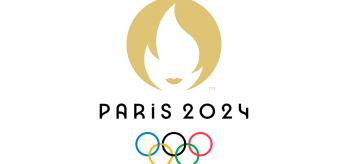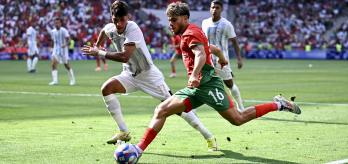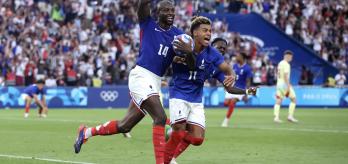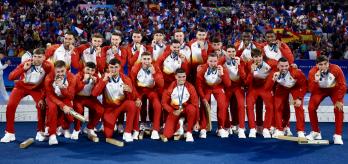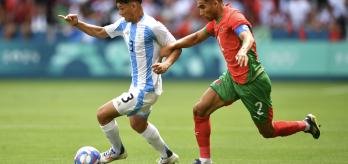Doing so effectively requires a strong ability to read the game, as the former Switzerland stopper explains:
“The first thing the goalkeeper must assess is whether the free-kick-taker can make an attempt at goal with their first strike of the ball,” he says. “If they can, then the goalkeeper’s priority is to defend their goal. If it is more likely that the first contact with ball will be a delivery into the penalty area, then the goalkeeper’s priority may change to defending the space.”
Decisiveness defending free kicks in France
An analysis of match data from the tournament by FIFA’s Football Performance Insights Team revealed that goalkeepers were pro-active in making interventions when defending free-kicks. It is important to point out that the numbers in the graphic below include both set-play aerial controls and defensive line supports by goalkeepers, meaning they count interventions by goalkeepers both in the air and on the ground. Up to and including the semi-finals, goalkeepers made an average of 0.73 interventions for every 60 minutes that the ball was in play. Morocco goalkeeper Munir El Kajoui (1) ranked number one for this statistic, with 2.41 interventions for every 60 minutes the ball was in play.
Factors in decision-making
As soon as the free-kick-taker places the ball, the goalkeeper has to start analysing the situation and come up with a plan for every eventuality. Questions they must ask themselves before the kick is taken include:
-
Whether the free-kick is direct or indirect
-
How far the ball is from goal
-
The angle between the ball and the goal
-
Whether the kick-taker will use their right or their left foot
-
How many players are standing over the ball, and which of them might take the kick
-
Whether the player taking the kick is a specialist (for instance, do they score from a lot of direct free-kicks?).
The decision-making in action
To illustrate how this process works in practice, Pascal Zuberbühler has picked out three clips that show the decision-making process preceding goalkeeper interventions.
Hamza Alaa - Egypt
The first of them focuses on Egypt’s Hamza Alaa (1). The Egyptian goalkeeper demonstrated exactly the decisiveness necessary to defend free kicks, according to Zuberbühler. “This clip shows Hamza Alaa starting very close to his line when the direct free-kick is lined up. The taker is right-footed and an attempt at goal is possible from this angle and distance, so the goalkeeper’s priority here is to defend his goal. As the taker runs up to strike the ball, Alaa remains on his line and makes the intervention. Even though the ball could have been delivered into the penalty area, his priority had to be defending the goal, so his decision was clear.”
Arnau Tenas - Spain
In clip 2, Spain goalkeeper Arnau Tenas (1) has a more complex decision to make. The free-kick is closer to goal and there are two potential takers standing over the ball. Moreover, one of them is right-footed while the other is left-footed, so the attacking side have a wide range of options. The first strike of the ball could be a right-footed attempt at goal, a right-footed in-swinging delivery, a left-footed attempt at goal, or a left-footed out-swinging delivery.
Fortunately for Spain, Tenas made the right decisions at the right times, as Zuberbühler explains:
“Here, Tenas starts on his goal line because there is a clear threat of an attempt at goal. As soon as the right-footed player runs over the ball, the goalkeeper can eliminate two threats, but an attempt at goal is still possible, so he stays on his line. Once the ball is in the air, he has a split second to judge the flight of the ball before he has to act to eliminate the threat of an attempt at goal. To deal with the danger, he takes very explosive first steps towards the ball, defending the space in his goal area and making the intervention ahead of any attacking opposition player. This type of action demands high-quality decision-making and takes courage and a strong mindset, because you have to change from defending the goal to defending the space so quickly.”
Geronimo Rulli - Argentina
Finally, in clip 3, it is Argentina ‘keeper Geronimo Rulli (1) who has to weigh up multiple threats to his goal. This time, there are two takers standing over the ball, which means he could be about to face a right-footed or left-footed attempt at goal. Alternatively, the two attackers are also capable of a range of deliveries into the penalty area, all of which have to be dealt with in different ways. On this occasion, the ball is over 36m from goal, meaning that the taker would have to come up with a very special strike to score. With that in mind, the goalkeeper’s main priority here is to defend the space, as opposed to protecting his goal.
Again, Zuberbühler was impressed by the goalkeeper’s judgement in this tricky situation:
“The free-kick-takers can shoot from here, but it’s a long way out, so it’s clear that Rulli must defend the space. His defenders are holding a high line, so he can advance from his line into the space. We see, just before the free-kick is taken, that he is in the set position, 3.71m from his goal line and just over 12m from his defensive line. As soon as the right-footed delivery is dispatched, he has time (because of the distance) to judge the flight of the ball, and he advances with explosive forward steps before getting two strong hands to the ball to punch it away from the danger area. This is a well-timed and well-judged defence of the space.”




